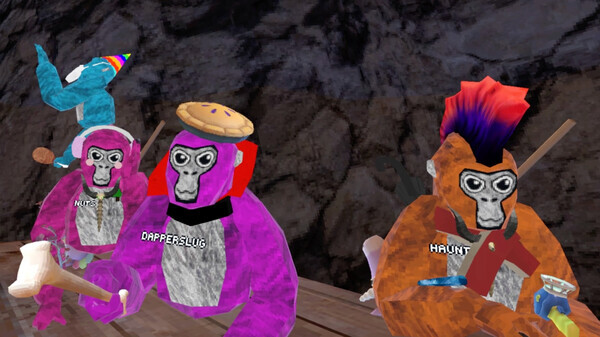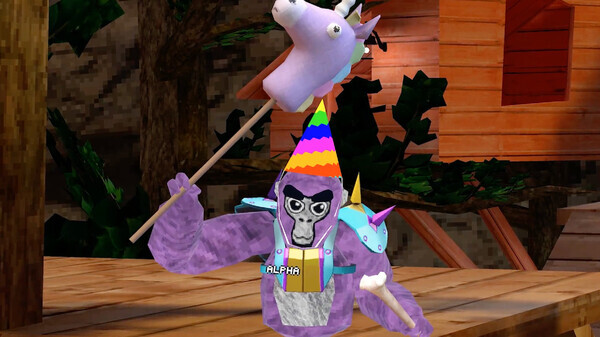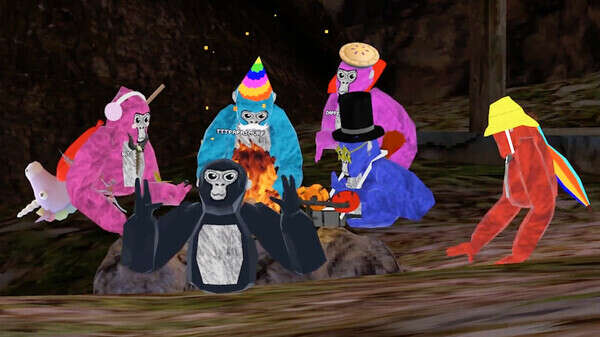If you don’t have kids, it’s quite possible you’ve never heard of Gorilla Tag, and if you do have kids, there’s a good chance Gorilla Tag is all you’ve been hearing about for a few years now. Originally developed by one person, Kerestell Smith–known to fans by his online handle Lemming–Gorilla Tag is the game of a generation. It hosts a million unique players daily, up to three million monthly active users, and has been played by over 12 million people since it released in 2021. While many older players have sometimes already written off VR, players of a particular age, approximately 7-14, have flocked to a game that is simple in its gameplay loop but sneakily complex in its design.
As both a writer in this space and the parent of a Gen Alpha kid who’s been shimmying through his bedroom as a virtual great ape for a few years now, I was excited to meet Smith and hear the complete Gorilla Tag origin story, learning why and how he believes Gorilla Tag overtook a generation, and what it means for the future of the platform.
“What’s really funny is that I didn’t set out to make a game that kids like. I just thought to make a game that I like,” Smith told me through a laugh as part of a sit-down conversation in Seattle during PAX West earlier this month. “So I don’t know what that says about my sensibilities for, like, what I want to do in VR.”
For the uninitiated, Gorilla Tag is an aptly named game. In it, players inhabit the bodies of gorillas and join a multiplayer world with others where they–you guessed it–play tag. Due to the playground-like nature of the world, however, players have branched out to make their own games, foster urban legends about the world, and use it as an online hangout space where the loose structure lets them join up and chat. Smith even told me his team holds meetings inside the game.
Because of several factors–its novel gameplay intentions, its low-poly (and now heavily memed) art style, its immense popularity despite being trapped in a VR bubble–Gorilla Tag has fascinated me for years, so I asked Smith to give me the game’s origin story. What I didn’t expect was a nearly 40-minute answer that ate up most of our initially allotted interview time. But his lengthy answer was illuminating, and we were able to stick around long after the scheduled end point so I could get in another dozen or so questions I still wanted to ask.
“I always just did [VR gaming] kind of as a hobby,” Smith told me, explaining that he never really had strong intentions to be a game developer. “I was just super into VR. I was playing all sorts of stuff. And then Echo Arena came out, and I remember thinking, ‘Oh, I’ll check it out, because it’s got zero-G.’ It seemed more like a sports-style game. And I don’t really care about sports-style games, but after I checked it out, it was like a switch was flipped.” Smith said his opinion went from “VR is the coolest video-game thing that’s come out in who-knows-how-long” to realizing “there’s something special about this,” and that “it’s not just gonna be a video-game thing.”
As he grinded to the top of the Echo Arena competitive leaderboards, Smith discovered that the game’s zero-G movement was so much like what he imagined the real thing to feel like that he became obsessed with ideas of virtual worlds that abide by their own internal logic, and do so consistently to the extent that they can immerse you in an experience unlike any other.
“If you have this really strong connection with your environment, if you push on the world, and the world pushes back, if it’s built in a way that feels real, has this subset of rules, internally consistent rules that the game follows, that you can learn and then just be immersed in the space, because you understand it, and then you put other people there, so you feel like you’re there, and you feel like other people are there,” Smith said. “That kind of connection you can have is second only to what you can form in real life.
“And that, to me, [is] the key power of the medium. That’s the thing that VR can do, that nothing else can do: give you that feeling that you’re in the same place as another person. It feels like you’re actually with somebody else. And those were the things that I focused on in Gorilla Tag. I tried to just cut out as much as I could and just focus on those things. Because it was like, ‘I want to build something and I want to release it, so I need to make it as small as I can,’ but what are the important parts? What are the things that can’t be left out?”
This led to the formation of what he calls the Three Axioms for his studio, Another Axiom. Smith explained this conceptual trio as the direct relationship between the player and the environment, building a plausible alternate reality with consistent internal rules that players can understand, and forming a connection to other people in-game. These axioms, Smith suggested, will also help shape the team’s next project, Orion Drift, which looks to build on Gorilla Tag’s social structure with massively expanded multiplayer worlds.

“I had been playing a lot of these different VR experiences and doing all these things, and I didn’t feel like I was seeing the kinds of things that hit on the aspects of the VR experiences that I was really connecting with. It was this sense of, ‘I don’t think the industry is moving forward as fast as I hoped it would have,’ but I saw these different developers doing these different pieces. Like, all these different experiences that are awesome in all these different ways, but they weren’t being pulled together and focused on. So I had this sense of, ‘Okay, well, if I think I’m so smart, I’m not just gonna post on internet forums and complain and be annoying or whatever. I have to put my money where my mouth is and try and make something.'”
Smith said he set out to make what would become Gorilla Tag “because I cared really deeply about VR and the medium, and my hope was, maybe if I make something really cool, then a real developer might try it out and be like, ‘Oh, there’s some cool ideas here.'”
Smith’s thoughts on his design intentions for Gorilla Tag were incredibly detailed, to an extent I found intriguing given how all of his purposeful planning surrounding the game’s locomotion mechanic, its refusal to embed the game in immersion-breaking menus, how he determined it would work best if avatars had no legs, and more are all ultimately experienced by a young playerbase generally lacking the vocabulary to express any of it, but they likely feel it as they play, and that’s why it works.
“Gorilla Tag, I can say very confidently, doesn’t have [avatar] legs, specifically because of my experience playing Raccoon Lagoon,” Smith told me. “It was a resource-gathering game, so you have the problem of, ‘Okay, I chopped down the tree, and I want to collect the logs, and the logs are on the ground, so I have to bend over to pick up the logs,’ and it’s kind of a pain in the butt to constantly have to do that. So [developer Hidden Path] just put you at torso height, so you chop a tree down, and you can just reach your arm out and pick it up.
“And I played it, and I noticed it didn’t feel weird that I was at torso height on the ground, and the ground was right there. It felt totally fine. So it got me thinking about how we have these preconceived notions of [how] a VR game should map to your body, but because you don’t have your legs as a controller, removing that actually makes it easier to interact with that virtual world.” This led to Gorilla tag’s arm-based mechanic where you pull yourself through the world similar to how a real gorilla moves. For those who have never seen it, it’s kind of like walking on stilts, only the skill ceiling is incredibly high, which Smith discovered months after the initial concept was pieced together, at a time when he’d added a multiplayer component that wasn’t initially there.
“I had this idea for tag, and I just threw it in there. And then all of a sudden, when you could see other people, and when you’re it and you’re chasing somebody, and your feeling is just, ‘I gotta get that guy,’ that’s such a primal thing, right? Tag is something that all mammals play, and it felt it was the exact same feeling. I have to move quickly to catch that person. If someone’s chasing you, you get kind of worried, so you end up moving a little bit more erratically, so you end up not being as fast, you’re easier to catch. Like, all these different aspects just kind of came together.”
This, Smith feels, points to the axiom of internal logic that, if made consistent, can allow players to adapt quickly. A VR world doesn’t have to be like real life. It doesn’t even have to look like real life, Smith said, recalling the platform’s early obsession with high-fidelity visuals. Targeting the original and underpowered Oculus Quest headset, Smith knew he would need to work within his limitations for Gorilla Tag, and he told me he was inspired by a YouTube channel called Alpha Beta Gamer that’s dedicated to playing under-the-radar indie games, many of which featured PS1-style visuals.

“I wanted to make everything for this game myself [and] that was an art style that was kind of accessible [to me], but it’s almost easier to buy into the world when it has this clear visual style that is not meant to look like real life,” Smith said. “It’s easier to buy into this other world that looks totally different and has this completely different feel to it, but you can still invest yourself in it because your brain doesn’t have this [feeling of], ‘Oh, sorry, this is too pixely to be real.'”
It was clear, when Smith finally took a breath, that he firmly believes in VR, not just as a current tech toy or a development tool for his sudden change of career, but as a platform with a foundation already sturdy enough today that he no longer worries about its future prospects.
“There’s so much work that’s been done to really flesh out what is valuable about the medium,” he said, “and now there’s this path forward to say, ‘Okay, let’s build on what’s been made before.’ It’s not just, ‘Let’s just keep trying new things and see what works.’ There’s enough of a body of work there that there’s really stuff to build on now.
“Video games are kind of hitting a renaissance right now, in some ways. You’re seeing all these new ideas come out. The tools are powerful enough that indie game developers can make these things that become mega, super hits out of nowhere. You know, Vampire Survivors, Palworld, all these things that are enabled by building off of what came before […] And I’m excited because, I think for VR, we don’t have to imagine anymore. You can see what’s happening with the industry, and you can see what things are building towards and what people are connecting with.”
Around the time of Gorilla Tag’s launch, Smith released the locomotion engine to be open-source. His hope was that other developers could take the basis of that movement mechanic and use it in interesting new games of their own. Instead, it spawned a wave of clones that, to this day, can be found in the Quest store. Initially, Smith grew frustrated and felt like his attempt to pay it forward in a developer sense was betrayed by people trying to cash in on his work.
“But then I thought about it more and paid attention, and [discovered] these are not other developers making [Gorilla Tag clones]. It’s kids. And I think a lot of artists start by doing things like tracing Goku. They’re not making incredible original art, but they’re so passionate about that one thing. That inspires them to want to do that. So seeing kids be interested enough in what we’re doing to [the extent that they] start copying it directly, I think it’s awesome […] That means that these are the kids who will later on become developers, and at that point, once they’ve got experience and understanding and knowledge, then they’ll want to be creating their own stuff. Like, these are the people who, in 10 years, will go into the VR industry as developers and make things.”
With years of success behind him and his team’s next game coming soon, Smith acknowledges a VR bubble but feels it’s only a matter of time until it pops. “The way I think about it is, you know when we were really young and our parents were telling us, ‘I don’t get why you kids are playing these games,’ right? And we’re like, ‘You just don’t understand.’ It was kind of generational, right? It’s not because they wouldn’t be able to have fun playing games, but they just didn’t even think of themselves as people who would play these games.
“And then, as we’ve gotten older, everybody in our generation plays video games, right? Video games are for everybody. It’s bigger than music, and movies, and TV, and all these things. Our parents didn’t understand that exactly, but it wasn’t that people of a certain age couldn’t get it. It was just people who didn’t grow up with it, who didn’t understand it, who were maybe not quite as open to these new experiences. And I think it’s a similar thing with VR. I think that the kids who are playing VR now are going to be playing it their entire lives.” Anecdotally, I told Smith I agreed. Kids in my son’s school play VR games much more often than people my age do. Most of the people I know in the games media industry don’t regularly play VR games, but it seems like younger generations are much more enthusiastic about it. As headsets get less bulky and more powerful–and these kids eventually have expendable income–it does seem like there is still a future for this tech that many wrote off years ago.

Smith added that his confidence in VR is backed by two specific reasons. One is because of that aforementioned foundation that he feels VR now benefits from; it’s found its footing, and from there, it can only improve. The second, which he returned to more often and fervently than any other in my 70-minute chat with him, is VR’s unique social dynamics.
“I really, truly believe in that social aspect,” he said. “That ability to create communities and spaces that is becoming more and more difficult these days. It seems like it’s really tough to raise kids, especially right now, compared to when we were younger. It’s harder for kids to just ride their bike to their friends’ houses, right? There are fewer spaces where it’s okay for teenagers to hang out together outside.
“But VR allows people to create these communities and spaces that they can just exist in and just hang out together. One of the things that I want people to feel about the games that we make is not like, ‘Gorilla Tag is really fun.’ It’s the feeling of being in that world with other people. It’s the same way that you can picture what it’s like to just hang out with your friends, or go and spend time at their house, or go visit the beach and just, you know, soak up the waves.”
A VR game, if done well, is not just an activity, Smith believes. In a manner unique to the platform, it can deliver on a feeling of “community,” he said, “and that is really powerful […] so powerful that I don’t see a way for VR to fail at this point.”
